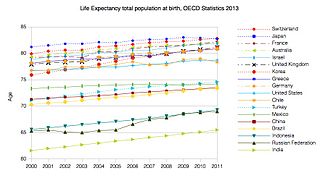Related Research Articles

An emergency department (ED), also known as an accident and emergency department (A&E), emergency room (ER), emergency ward (EW) or casualty department, is a medical treatment facility specializing in emergency medicine, the acute care of patients who present without prior appointment; either by their own means or by that of an ambulance. The emergency department is usually found in a hospital or other primary care center.
Health care in Ireland is delivered through public and private healthcare. The public health care system is governed by the Health Act 2004, which established a new body to be responsible for providing health and personal social services to everyone living in Ireland – the Health Service Executive. The new national health service came into being officially on 1 January 2005; however the new structures are currently in the process of being established as the reform programme continues. In addition to the public-sector, there is also a large private healthcare market.

Netcare Limited is a South African private healthcare company. It operates through a number of subsidiaries and employs just over 21 000 people.
Health care in Saudi Arabia is a national health care system in which the government provides free universal healthcare coverage through a number of government agencies. There is also a growing role and increased participation from the private sector in the provision of health care services. Saudi Arabia has been ranked among the 26 best countries in providing high quality healthcare.

The healthcare delivery system of Pakistan is complex because it includes healthcare subsystems by federal governments and provincial governments competing with formal and informal private sector healthcare systems. Healthcare is delivered mainly through vertically managed disease-specific mechanisms. The different institutions that are responsible for this include: provincial and district health departments, parastatal organizations, social security institutions, non-governmental organizations (NGOs) and private sector. The country's health sector is also marked by urban-rural disparities in healthcare delivery and an imbalance in the health workforce, with insufficient health managers, nurses, paramedics and skilled birth attendants in the peripheral areas. Pakistan's gross national income per capita in 2021 was $4,990 and the total expenditure on health per capita in 2021 was Rs 657.2 Billions, constituting 1.4% of the country's GDP. The health care delivery system in Pakistan consists of public and private sectors. Under the constitution, health is primarily responsibility of the provincial government, except in the federally administrated areas. Health care delivery has traditionally been jointly administered by the federal and provincial governments with districts mainly responsible for implementation. Service delivery is being organized through preventive, promotive, curative and rehabilitative services. The curative and rehabilitative services are being provided mainly at the secondary and tertiary care facilities. Preventive and promotive services, on the other hand, are mainly provided through various national programs; and community health workers’ interfacing with the communities through primary healthcare facilities and outreach activities. The state provides healthcare through a three-tiered healthcare delivery system and a range of public health interventions. Some government/ semi government organizations like the armed forces, Sui Gas, WAPDA, Railways, Fauji Foundation, Employees Social Security Institution and NUST provide health service to their employees and their dependents through their own system, however, these collectively cover about 10% of the population. The private health sector constitutes a diverse group of doctors, nurses, pharmacists, traditional healers, drug vendors, as well as laboratory technicians, shopkeepers and unqualified practitioners.

The Ministry of Health is the ministry of the Government of Turkey responsible for proposing and executing the government policy on health, planning and providing healthcare and protecting consumers. Likewise, it is responsible for proposing and executing the government policy on social cohesion and inclusion, family, protection of minors, youth and of care for dependent or disabled persons. The Ministry is headquartered in the Bakanlıklar in Ankara.
Healthcare in Brazil is a constitutional right. It is provided by both private and government institutions. The Health Minister administers national health policy. Primary healthcare remains the responsibility of the federal government, elements of which are overseen by individual states. Public healthcare is provided to all Brazilian permanent residents and foreigners in Brazilian territory through the National Healthcare System, known as the Unified Health System. The SUS is universal and free for everyone.

Healthcare in Singapore or the Singapore healthcare system is under the purview of the Ministry of Health of the Government of Singapore. It mainly consists of a government-run publicly funded universal healthcare system, delivered through schemes such as Medisave, Medishield Life and Medifund, while also including a significant private healthcare sector. In addition, financing of healthcare costs is done through a mixture of direct government subsidies, compulsory comprehensive savings, a national healthcare insurance, and cost sharing.

The Healthcare in Kazakhstan is a post-Soviet healthcare system under reform. The World Health Organization (WHO), in 2000, ranked the Kazakhstani healthcare system as the 64th in overall performance, and 135th by overall level of health.

Healthcare in Taiwan is administered by the Ministry of Health and Welfare of the Executive Yuan. As with other developed economies, Taiwanese people are well-nourished but face such health problems as chronic obesity and heart disease. In 2002 Taiwan had nearly 1.6 physicians and 5.9 hospital beds per 1,000 population. In 2002, there were 36 hospitals and 2,601 clinics in the country. Per capita health expenditures totaled US$752 in 2000. Health expenditures constituted 5.8 percent of the gross domestic product (GDP) in 2001 ; 64.9 percent of the expenditures were from public funds. Overall life expectancy in 2019 was averaged at 81 years.
Kenya’s health care system is structured in a step-wise manner so that complicated cases are referred to a higher level. Gaps in the system are filled by private and church run units.
Healthcare in Georgia is provided by a universal health care system under which the state funds medical treatment in a mainly privatized system of medical facilities. In 2013, the enactment of a universal health care program triggered universal coverage of government-sponsored medical care of the population and improving access to health care services. Responsibility for purchasing publicly financed health services lies with the Social Service Agency (SSA).

Healthcare in Serbia is delivered by means of a universal health care system.

This article provides a brief overview of the health care systems of the world, sorted by continent.
According to the Constitution of Albania, citizens are entitled to healthcare. The healthcare system in Albania is primarily public. The public system is made up of three tiers: primary care, secondary care, and tertiary care. Primary healthcare covers basic health needs. Secondary healthcare is needed when seeing a specialist after being referred to by a general doctor. Tertiary healthcare funds highly specialized medical care that is needed over a long duration of time. There are over 400 public clinics that offer both primary and secondary healthcare services, along with over 40 public hospitals that offer tertiary healthcare services.

As of 2019 Lithuanian life expectancy at birth was 76.0 and the infant mortality rate was 2.99 per 1,000 births. This is below the EU and OECD average.
Modern Mongolia inherited a relatively good healthcare system from its socialist period, a world bank report from 2007 notes "despite its low per capita income, Mongolia has relatively strong health indicators; a reflection of the important health gains achieved during the socialist period." On average Mongolia's infant mortality rate is less than half of that of similarly economically developed countries, its under-five mortality rate and life expectancy are all better on average than other nations with similar GDP per capita.

Healthcare in Belize is provided through both public and private healthcare systems. The Ministry of Health (MoH) is the government agency responsible for overseeing the entire health sector and is also the largest provider of public health services in Belize. The MoH offers affordable care to a majority of Belizeans with a strong focus on providing quality healthcare through a range of public programs and institutions.

In the past, Kosovo’s capabilities to develop a modern health care system were limited. Low GDP during 1990 worsened the situation even more. However, the establishment of the Faculty of Medicine in the University of Pristina marked a significant development in health care. This was also followed by launching different health clinics which enabled better conditions for professional development.

The COVID-19 pandemic has impacted hospitals around the world. Many hospitals have scaled back or postponed non-emergency care. This has medical consequences for the people served by the hospitals, and it has financial consequences for the hospitals. Health and social systems across the globe are struggling to cope. The situation is especially challenging in humanitarian, fragile and low-income country contexts, where health and social systems are already weak. Health facilities in many places are closing or limiting services. Services to provide sexual and reproductive health care risk being sidelined, which will lead to higher maternal mortality and morbidity. The pandemic also resulted in the imposition of COVID-19 vaccine mandates in places such as California and New York for all public workers, including hospital staff.
References
- ↑ "Human Rights Measurement Initiative – The first global initiative to track the human rights performance of countries". humanrightsmeasurement.org. Retrieved 2022-03-18.
- 1 2 3 4 "Guyana - HRMI Rights Tracker". rightstracker.org. Retrieved 2022-03-18.
- 1 2 "South America :: Guyana — The World Factbook - Central Intelligence Agency". www.cia.gov. Retrieved 2020-12-10.
- 1 2 "CDC Global Health - Guyana". www.cdc.gov. 2019-02-28. Retrieved 2020-12-11.
- 1 2 3 4 "Guyana" . Retrieved 2020-12-11.
- ↑ Aicken, David (August 2001). "From Plantation Medicine to Public Health: The State and Medicine in British Guiana 1838 - 1914" (PDF). University College London. Retrieved 2021-01-15.
- ↑ "Guyana - Health". countrystudies.us. Retrieved 2020-12-11.
- ↑ "Guyana - Health and Welfare Services". countrystudies.us. Retrieved 2020-12-11.
- ↑ Forget, Nicolas P.; Rohde, John Paul; Rambaran, Navindranauth; Rambaran, Madan; Wright, Seth W. (2013). "Emergency Medicine in Guyana: Lessons from Developing the Country's First Degree-conferring Residency Program". Western Journal of Emergency Medicine. 14 (5): 477–481. doi:10.5811/westjem.2013.3.12714. ISSN 1936-900X. PMC 3789912 . PMID 24106546.
- ↑ Misir, Prem (2014-06-18). "Healthcare in Guyana". www.socialmedicine.info. Retrieved 2020-12-14.
- 1 2 3 "WHO-AIMS Report on Mental Health System in Guyana" (PDF). WHO and Ministry of Health. 2008. Retrieved 2020-12-18.
- ↑ "Guyana's Mental Health Care Shortage". Global Health NOW. Retrieved 2020-12-11.
- ↑ "94-year-old's sight restored by Chinese Medical Brigade". Stabroek News. 2016-10-01. Retrieved 2020-12-14.
- ↑ "China makes $25M equipment donation to Health Ministry". Stabroek News. 2012-10-24. Retrieved 2020-12-14.
- ↑ Vansell, H. J.; Schlesinger, J. J.; Harvey, A.; Rohde, J. P.; Persaud, S.; McQueen, K. A. (2014-10-07). "Anaesthesia, surgery, obstetrics, and emergency care in Guyana". Journal of Epidemiology and Global Health. 5 (1): 75–83. doi: 10.1016/j.jegh.2014.08.003 . ISSN 2210-6014. PMC 7320350 . PMID 25700926.
- ↑ "The State of World's Midwifery 2011: Delivering Health, Saving Lives". United Nations Population Fund. Archived from the original on 2011-08-19. Retrieved 1 August 2011.
- ↑ WHO Report 2014 Preventing suicide: A global imperative.
- ↑ "BBCCaribbean.com". Bbc.co.uk. 2008-01-11. Retrieved 2010-05-02.

